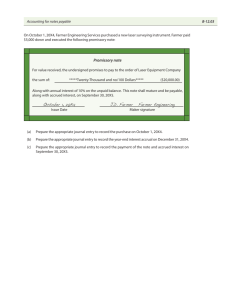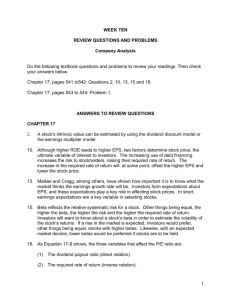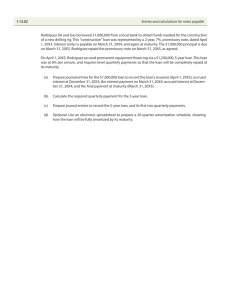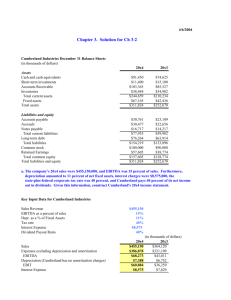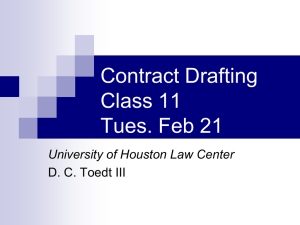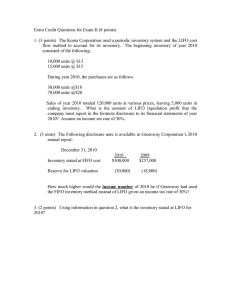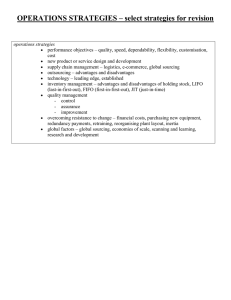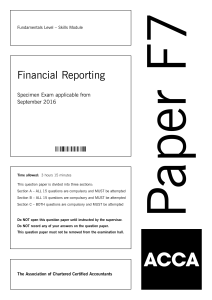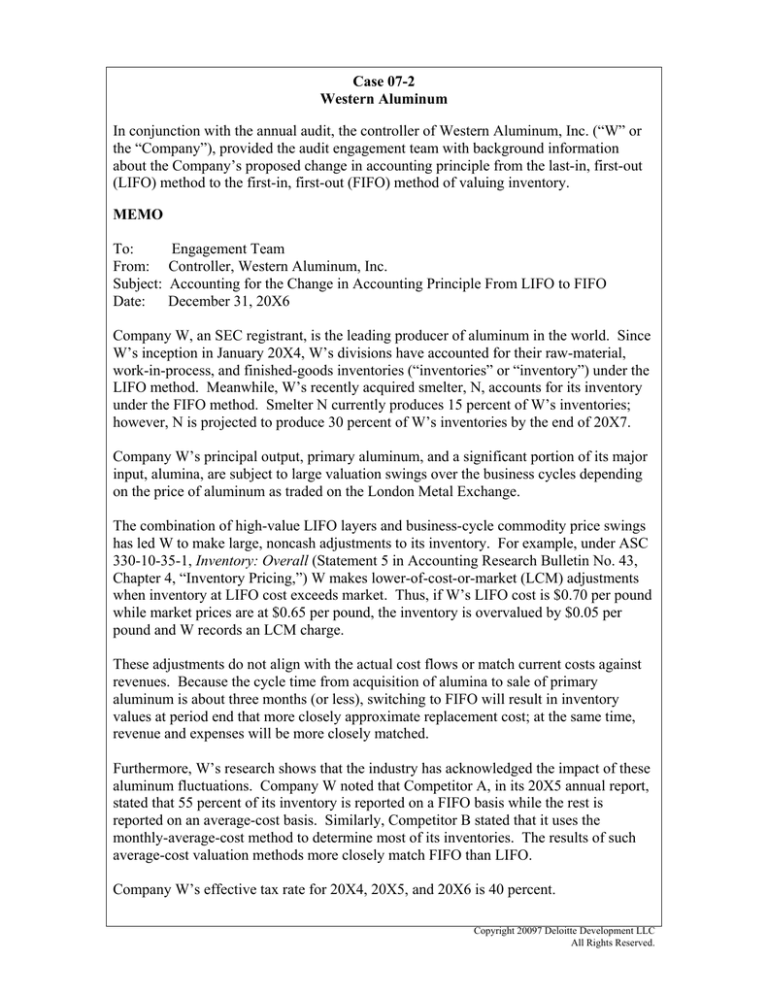
Case 07-2
Western Aluminum
In conjunction with the annual audit, the controller of Western Aluminum, Inc. (“W” or
the “Company”), provided the audit engagement team with background information
about the Company’s proposed change in accounting principle from the last-in, first-out
(LIFO) method to the first-in, first-out (FIFO) method of valuing inventory.
MEMO
To:
From:
Subject:
Date:
Engagement Team
Controller, Western Aluminum, Inc.
Accounting for the Change in Accounting Principle From LIFO to FIFO
December 31, 20X6
Company W, an SEC registrant, is the leading producer of aluminum in the world. Since
W’s inception in January 20X4, W’s divisions have accounted for their raw-material,
work-in-process, and finished-goods inventories (“inventories” or “inventory”) under the
LIFO method. Meanwhile, W’s recently acquired smelter, N, accounts for its inventory
under the FIFO method. Smelter N currently produces 15 percent of W’s inventories;
however, N is projected to produce 30 percent of W’s inventories by the end of 20X7.
Company W’s principal output, primary aluminum, and a significant portion of its major
input, alumina, are subject to large valuation swings over the business cycles depending
on the price of aluminum as traded on the London Metal Exchange.
The combination of high-value LIFO layers and business-cycle commodity price swings
has led W to make large, noncash adjustments to its inventory. For example, under ASC
330-10-35-1, Inventory: Overall (Statement 5 in Accounting Research Bulletin No. 43,
Chapter 4, “Inventory Pricing,”) W makes lower-of-cost-or-market (LCM) adjustments
when inventory at LIFO cost exceeds market. Thus, if W’s LIFO cost is $0.70 per pound
while market prices are at $0.65 per pound, the inventory is overvalued by $0.05 per
pound and W records an LCM charge.
These adjustments do not align with the actual cost flows or match current costs against
revenues. Because the cycle time from acquisition of alumina to sale of primary
aluminum is about three months (or less), switching to FIFO will result in inventory
values at period end that more closely approximate replacement cost; at the same time,
revenue and expenses will be more closely matched.
Furthermore, W’s research shows that the industry has acknowledged the impact of these
aluminum fluctuations. Company W noted that Competitor A, in its 20X5 annual report,
stated that 55 percent of its inventory is reported on a FIFO basis while the rest is
reported on an average-cost basis. Similarly, Competitor B stated that it uses the
monthly-average-cost method to determine most of its inventories. The results of such
average-cost valuation methods more closely match FIFO than LIFO.
Company W’s effective tax rate for 20X4, 20X5, and 20X6 is 40 percent.
Copyright 20097 Deloitte Development LLC
All Rights Reserved.
Case 07-2: Western Aluminum
Page 2
Under the circumstances, W believes that changing to the FIFO method for its domestic
operations would be preferable. Company W proposes to make this accounting change in
the fourth quarter of calendar year 20X6 (December 31, 20X6).
The following table presents the effects of the proposed change in accounting principle
on inventory and cost of sales:
Date
1/1/20X4
Inventory Determined by
LIFO
FIFO
Method
Method
$
$
-
12/31/20X4
12/31/20X5
100
150
Cost of Sales Determined by
LIFO Method
$
-
FIFO Method
$
-
300
350
310
365
90
125
W has not filed audited financial statements with the SEC for the year ended December
31, 20X6. Company W’s audited financial statements as of, and for, the years ended
December 31, 20X5, and 20X4, as originally reported under the LIFO method, are as
follows:
Income Statement
20X5
Sales
Cost of goods sold
Selling, general, and administrative expenses
Income before income taxes
Income taxes
Net income
$
20X4
700
350
100
250
100
150
$
Balance Sheet
$
650
300
80
270
108
162
$
20X5
Cash
Inventory
Prepaid assets
$
Total Current Assets
Property, plant, and equipment (net)
10
150
5
165
$
1,065
$
Total Assets
20X4
1,230
20
100
15
135
630
$
765
Accounts payable
Income tax payable
Total Current Liabilities
268
100
368
100
108
208
Long-term liabilities
455
300
Paid-in capital
Retained earnings
95
312
407
95
162
257
Total Equity
Total Liabilities and Equity
$
1,230
$
765
Copyright 2009 Deloitte Development LLC
All Rights Reserved.
Case 07-2: Western Aluminum
Cash Flow Statement
Net income
Adjustments to reconcile net income
to net cash provided by operating activities
(Increase)/decrease in inventory
Increase/(decrease) in income tax liability
Page 3
20X5
$
Other operating, investing, and
financing cash flow activities:
Net increase/(decrease) in cash
Beginning cash balance
Ending cash balance
$
20X4
150
$
162
(50)
(8)
(100)
108
(102)
(150)
(10)
20
20
-
10
$
20
NOTE: For simplicity, the cash flow statements for the years ended December 31, 20X5,
and 20X4, are condensed, highlighting only those line items affected by the accounting
change. This summarized presentation does not comply with the requirements of ASC
230-10, Statement of Cash Flows: Overall (FASB Statement No. 95, Statement of Cash
Flows and related interpretations.) In addition, the statement of shareholders’ equity has
intentionally been omitted.
Required:
• What factors should the Company and the audit engagement team consider in
determining whether the proposed accounting change from LIFO to FIFO is
preferable?
•
If the change in accounting principle is preferable and indirectly results in a $100
increase in accrued bonuses by December 31, 20X5, how should the Company
report the indirect effects due to retrospective application in the financial
statements as of, and for, the year ended December 31, 20X5? Please explain.
•
Assume that the change in accounting principle is determined to be preferable, but
the Company concludes that it is impracticable to determine the period-specific
effects of the change in financial reporting periods at and before December 31,
20X5. How should the Company report the retrospective application for the
change in accounting principle in its annual report for December 31, 20X6?
•
Assume that the change in accounting principle is determined to be preferable and
that retrospective application is deemed practicable. Use the forms below to
adjust the financial statements as of, and for, the years ended December 31, 20X5,
and 20X4, to reflect the retrospective application of the change in accounting
principle that will be reported in the Company’s December 31, 20X6, annual
report on Form 10-K.
Copyright 2009 Deloitte Development LLC
All Rights Reserved.
Case 07-2: Western Aluminum
Page 4
NOTE: No cumulative adjustments need to be made to January 1, 20X4, retained
earnings since the Company’s business inception was January 20X4. Financial
statements as of, and for, the year ended December 31, 20X6, are not provided since they
have not previously been issued.
20X4:
As Originally
Reported
20X4
Income Statement
Sales
Cost of goods sold
Selling, general, and administrative
expenses
Income before income taxes
Income taxes
Net income
$
$
Property, plant, and equipment (net)
20
100
15
630
$
765
Accounts payable
Income tax payable
Total Current Liabilities
100
108
208
Long-term liabilities
300
Paid-in capital
Retained earnings
95
162
257
Total Equity
Total Liabilities and Equity
As Adjusted
20X4
270
108
162
135
Total Current Assets
Total Assets
Effect of
Change
20X4
650
300
As Originally
Reported
20X4
Cash
Inventory
Prepaid assets
As Adjusted
20X4
80
$
Balance Sheet
Effect of
Change
20X4
$
765
Copyright 2009 Deloitte Development LLC
All Rights Reserved.
Case 07-2: Western Aluminum
Cash Flow Statement
Net income
Adjustments to reconcile net income
to net cash provided by operating activities
Page 5
As Originally
Reported
20X4
$
Effect of
Change
20X4
As Adjusted
20X4
162
(100)
(Increase)/decrease in inventory
Increase/(decrease) in income tax
liability
108
Other operating, investing and
financing cash flow activities:
(150)
Net increase/(decrease) in cash
20
Beginning cash balance
Ending cash balance
20
$
20X5:
As Originally
Reported
20X5
Income Statement
Sales
Cost of goods sold
Selling, general, and administrative
expenses
$
As Adjusted
20X5
700
350
100
250
Income before income taxes
Income taxes
Net income
Effect of
Change
20X5
$
100
150
Copyright 2009 Deloitte Development LLC
All Rights Reserved.
Case 07-2: Western Aluminum
Page 6
As Originally
Reported
20X5
Balance Sheet
Cash
Inventory
Prepaid assets
$
165
Property, plant, and equipment
(net)
1,065
$
1,230
Accounts payable
Income tax payable
Total Current Liabilities
268
100
368
Long-term liabilities
455
Paid-in capital
Retained earnings
95
312
407
Total Equity
Total Liabilities and Equity
$
Cash Flow Statements
Net income
Adjustments to reconcile net income
to net cash provided by operating
activities
1,230
As Originally
Reported
20X5
$
Effect of
Change
20X5
As Adjusted
20X5
150
(50)
(Increase)/decrease in inventory
Increase/(decrease) in income
tax liability
(8)
Other operating, investing, and
financing cash flow activities:
(102)
(10)
Net Increase/(decrease) in Cash
20
Beginning cash balance
Ending cash balance
As Adjusted
20X5
10
150
5
Total Current Assets
Total Assets
Effect of
Change
20X5
$
10
Copyright 2009 Deloitte Development LLC
All Rights Reserved.
Case 07-2: Western Aluminum
Page 7
NOTE: For simplicity, the cash flow statements for the years ended December 31, 20X5,
and 20X4, are condensed, highlighting only those line items affected by the accounting
change. This summarized presentation does not comply with the requirements of ASC
230-10 (Statement 95 and related interpretations.) In addition, the statement of
shareholders’ equity has intentionally been omitted.
Copyright 2009 Deloitte Development LLC
All Rights Reserved.

